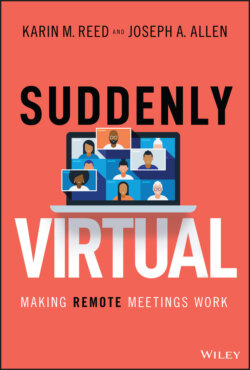Читать книгу Suddenly Virtual - Karin M. Reed - Страница 14
What Happened to Meetings?
ОглавлениеJust prior to the pandemic in October 2019, Joe had the fortunate chance to collect data concerning virtual meetings with his colleagues at the University of Nebraska at Omaha. Although the data was limited to U.S. workers, its meaning increased dramatically as 2020 unfolded. In October 2019, nearly 80% of meetings were face‐to‐face, with less than 4% held over video. A little more than 13% of meetings were classified as hybrid, which refers to meetings where a couple of people may be in one conference room talking to folks in another conference room in another city, or country, via telephone or video conference. Thus, the vast majority of us essentially met face‐to‐face, be it in our office, our conference rooms, at our favorite coffee shops, restaurants, or even bars. As the bar graph below shows, things changed both dramatically and quickly.
After the onset of the pandemic, meetings became suddenly virtual. Workers experienced a 60% jump of meetings on video – almost 20 times the rate from before COVID‐19. Telephone meetings jumped to nearly 25% of our meetings while face‐to‐face meetings were one‐seventh its former total. In other words, we stopped meeting face‐to‐face, except in certain occupations deemed essential such as medical doctors, nurses, and other healthcare providers. However, even healthcare saw a rapid rise in telehealth. According to a survey by Sermo, an online physician network, 85% of physicians had adopted telehealth (typically video visits with patients), and 60% said they planned to continue using telehealth even after the pandemic is in the past (Wicklund 2020).
Unsurprisingly, videoconferencing software boomed. Total video calls in Microsoft Teams experienced 1000% growth in March 2020 alone (Spataro 2020). Zoom, Webex, Google groups, BlueJeans, Skype, and other software saw similar or even greater growth during that same time. The default camera in many people's laptops went from being covered with tape for “privacy” to being a window into our homes and the homes of our colleagues, as videoconferencing became the main way for us to meet and collaborate during a pandemic.
Large meetings and conferences shifted to virtual as well, sometimes with lightning‐fast response times. Artificial Intelligence (AI) company Nuance took its global research and development (R&D) conference online in a matter of days using a Microsoft Teams channel and a PDF agenda with links to session events. Hundreds of attendees were able to benefit from the wealth of cutting‐edge information shared through a conference that cost Nuance almost nothing to put on. The previous year's event cost Nuance approximately $700,000 (Spataro 2020). CompTIA, a nonprofit trade association in the IT industry, made the pivot to all virtual. Ten days prior to a long‐planned, in‐person conference in Chicago, they decided to flip the switch and take it all online. The painstakingly prepared agenda, chock‐full of working group meetings, speakers, sessions, and even a St. Patrick's Day celebration along the dyed‐green Chicago River, was reworked for the new platform. And it worked – the virtual event attracted five times more people than were expected to attend the Chicago event, and CompTIA called the industry response to the conference “overwhelmingly positive” (Campbell 2020). The trend continued for months to come. Joe's professional conference, the Society for Industrial and Organizational Psychology (SIOP) conference, was online in June 2020, and the Interdisciplinary Network for Group Researchers (INGRoup) was online in October 2020.
